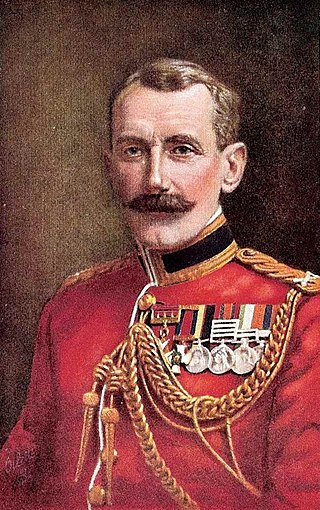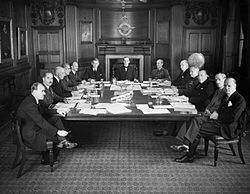
The Admiralty was a department of the Government of the United Kingdom responsible for the command of the Royal Navy until 1964, historically under its titular head, the Lord High Admiral – one of the Great Officers of State. For much of its history, from the early 18th century until its abolition, the role of the Lord High Admiral was almost invariably put "in commission" and exercised by the Lords Commissioner of the Admiralty, who sat on the governing Board of Admiralty, rather than by a single person. The Admiralty was replaced by the Admiralty Board in 1964, as part of the reforms that created the Ministry of Defence and its Navy Department.

The Ministry of Defence is a ministerial department of the Government of the United Kingdom. It is responsible for implementing the defence policy set by the government and serves as the headquarters of the British Armed Forces.

The Royal Flying Corps (RFC) was the air arm of the British Army before and during the First World War until it merged with the Royal Naval Air Service on 1 April 1918 to form the Royal Air Force. During the early part of the war, the RFC supported the British Army by artillery co-operation and photographic reconnaissance. This work gradually led RFC pilots into aerial battles with German pilots and later in the war included the strafing of enemy infantry and emplacements, the bombing of German military airfields and later the strategic bombing of German industrial and transport facilities.

Marshal of the Royal Air Force Hugh Montague Trenchard, 1st Viscount Trenchard, was a British officer who was instrumental in establishing the Royal Air Force. He has been described as the "Father of the Royal Air Force."

The Royal Naval Air Service (RNAS) was the air arm of the Royal Navy, under the direction of the Admiralty's Air Department, and existed formally from 1 July 1914 to 1 April 1918, when it was merged with the British Army's Royal Flying Corps to form the Royal Air Force (RAF), the world's first independent air force.

Marshal of the Royal Air Force (MRAF) is the highest rank in the Royal Air Force (RAF). In peacetime it was granted to RAF officers in the appointment of Chief of the Defence Staff (CDS), and to retired Chiefs of the Air Staff (CAS), who were promoted to it on their last day of service. While surviving Marshals of the RAF retain the rank for life, the highest rank to which officers on active service are promoted is now air chief marshal. Although general promotions to Marshal of the Royal Air Force have been discontinued since the British defence cuts of the 1990s, further promotions to the rank may still be made in wartime, for members of the Royal Family and certain very senior RAF air officers in peacetime at the discretion of the monarch; all such promotions in peacetime are only honorary, however. In 2012, the then Prince of Wales was promoted to the rank in recognition of his support for his mother, Queen Elizabeth II, in her capacity as head of the armed forces (commander-in-chief), while in 2014 Lord Stirrup, who had served as Chief of the Air Staff and Chief of the Defence Staff for over seven years, was also promoted.

The Air Department of the British Admiralty was established prior to World War I by Winston Churchill to administer the Royal Naval Air Service.

The Chief of the Air Staff (CAS) is the professional head of the Royal Air Force and a member of both the Chiefs of Staff Committee and the Air Force Board. The post was created in 1918 with Major General Sir Hugh Trenchard as the first incumbent. The current and 30th Chief of the Air Staff is Air Chief Marshal Sir Richard Knighton, who succeeded Sir Michael Wigston on 2 June 2023.

Air Vice Marshal Sir Frederick Hugh Sykes, was a British military officer and politician.
The history of the Royal Air Force, the air force of the United Kingdom, spans a century of British military aviation.

The Fifth Sea Lord was formerly one of the Naval Lords and members of the Board of Admiralty that controlled the Royal Navy. The post's incumbent had responsibility for naval aviation.

Lieutenant General Sir David Henderson, was the senior leader of British military aviation during the First World War, having previously established himself as the leading authority on tactical intelligence in the British Army. He served as the commander of the Royal Flying Corps in the field during the first year of the First World War, and was instrumental in establishing the Royal Air Force as an independent service. After the war Henderson was the first Director-General of the League of Red Cross Societies.

Admiral Mark Edward Frederic Kerr, was a Royal Navy and Royal Air Force officer during the First World War. Kerr was the Commander-in-Chief of the Royal Hellenic Navy in the early part of the First World War, Commander-in-Chief of the British Adriatic Squadron in 1916 and 1917 and was involved in the work to create the Royal Air Force in late 1917 and early 1918.

Royal Air Force Upavon, or more simply RAF Upavon, is a former Royal Air Force station in Wiltshire, England. It was a grass airfield, military flight training school, and administrative headquarters of the Royal Air Force. The station opened in 1912 and closed in 1993, when it was transferred to the British Army and became known as Trenchard Lines.
The fifth expedition of the Somaliland campaign, which took place in 1920, was the final British expedition against the Dervish forces. Although the majority of the combat took place in January, British troops had begun preparations for the assault as early as November 1919. The British forces included elements of the Royal Air Force and the Somaliland Camel Corps. After three weeks of battle, Diriye Guure's Dervishes were defeated, bringing an effective end to their 20-year resistance.
The Independent Air Force (IAF), also known as the Independent Force or the Independent Bombing Force and later known as the Inter-Allied Independent Air Force, was a First World War strategic bombing force which was part of Britain's Royal Air Force and was used to strike against German railways, aerodromes, and industrial centres without co-ordination with the Army or Navy.

The Royal Air Force College (RAFC) is the Royal Air Force academy which provides initial training to all RAF personnel who are preparing to become commissioned officers. The College also provides initial training to aircrew cadets and is responsible for all RAF recruiting along with officer and aircrew selection. Originally established as a naval aviation training centre during World War I, the College was established as the world's first air academy in 1919. During World War II, the College was closed and its facilities were used as a flying training school. Reopening after the War, the College absorbed the Royal Air Force Technical College in 1966.
The air commanders of World War I were army or navy officers who came to command air services during the first major conflict in which air power played a significant role.
RAF Coastal Area was a formation within the Royal Air Force (RAF). Founded in 1919, it was to act as the RAF's premier maritime arm. It was replaced by RAF Coastal Command on 14 July 1936.














